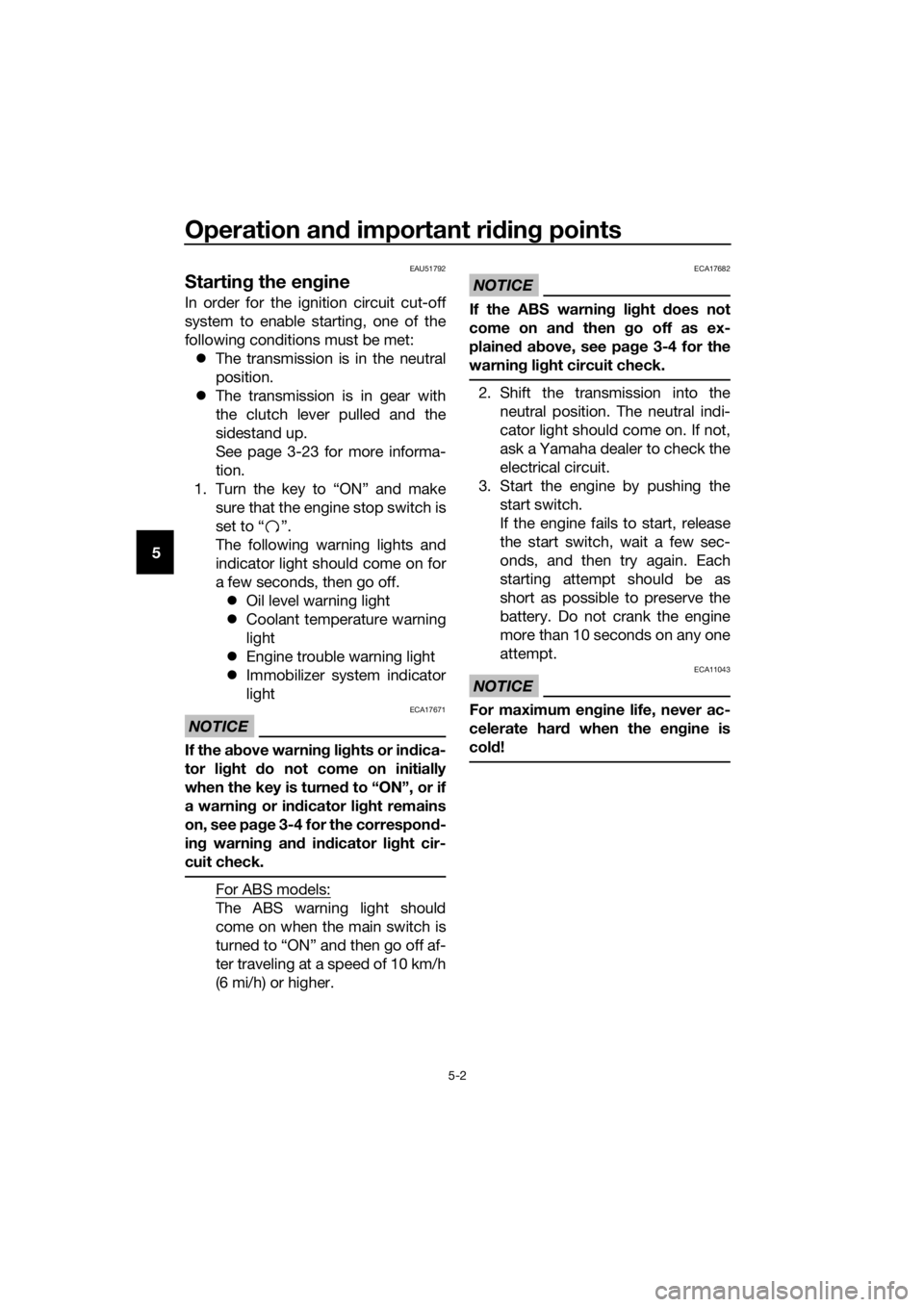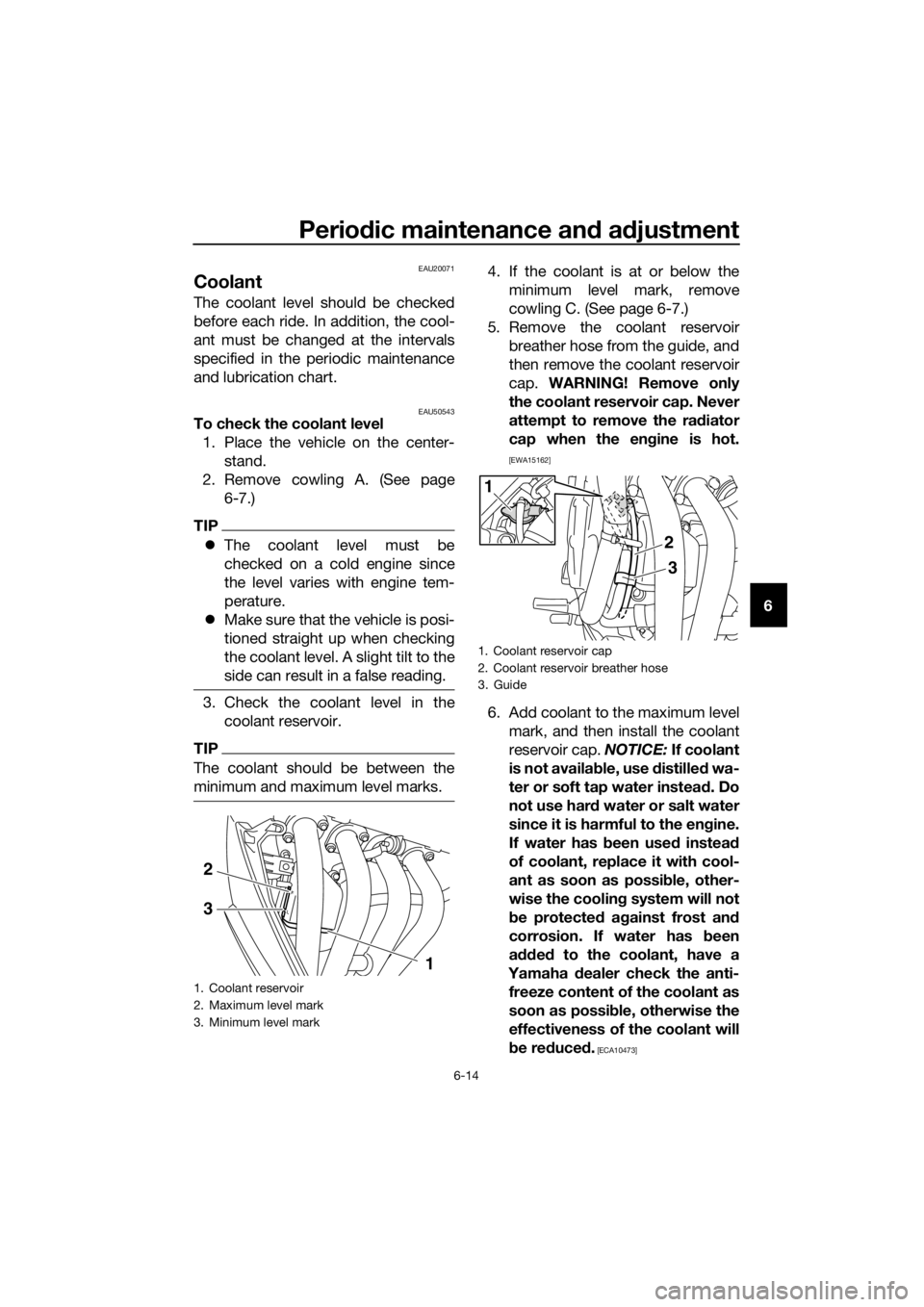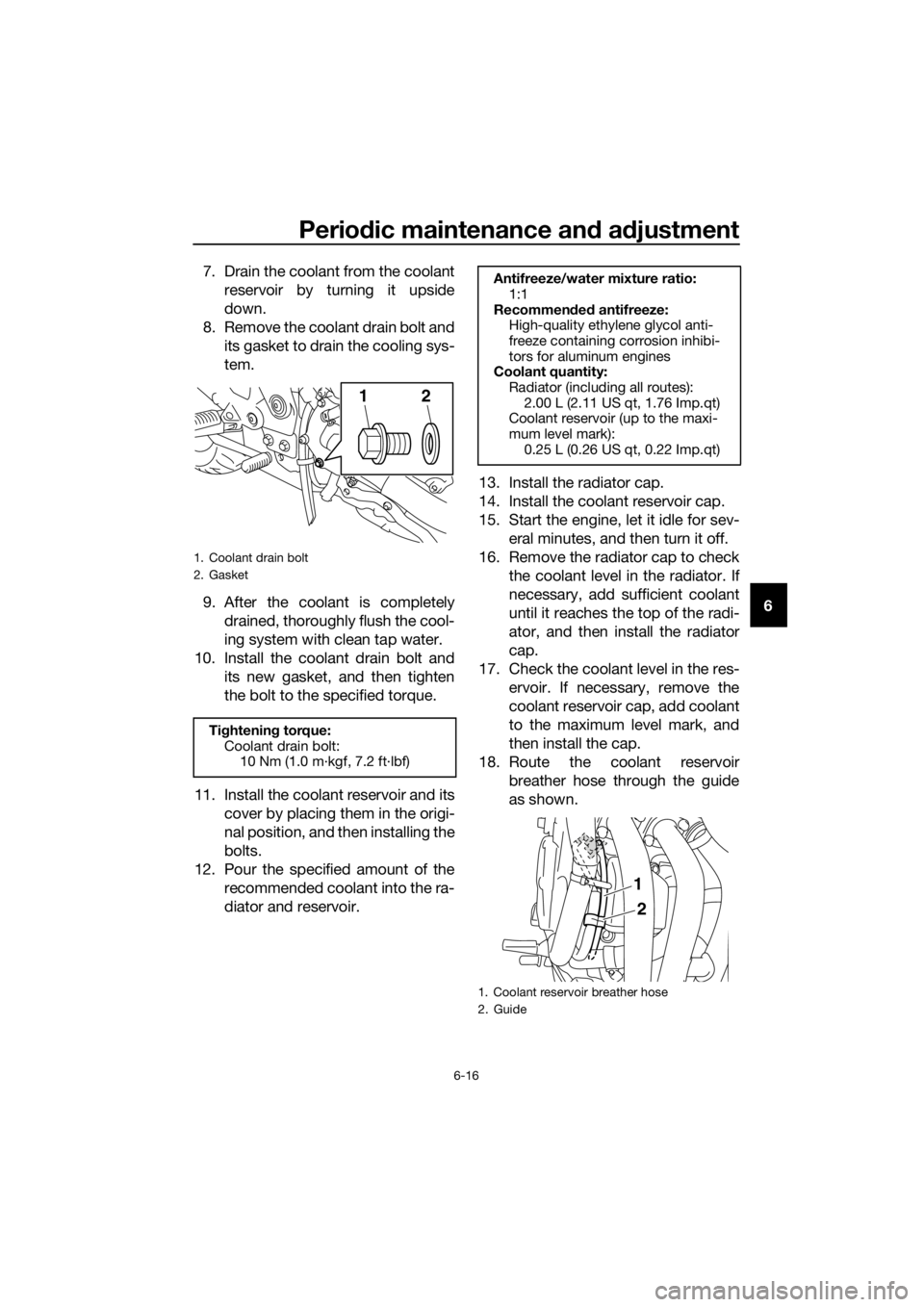coolant level YAMAHA XJ6F 2016 Owners Manual
[x] Cancel search | Manufacturer: YAMAHA, Model Year: 2016, Model line: XJ6F, Model: YAMAHA XJ6F 2016Pages: 104, PDF Size: 2.88 MB
Page 5 of 104

Table of contents
Safety information ............................1-1
Description ........................................2-1
Left view ..........................................2-1
Right view........................................2-2
Controls and instruments ................2-3
Instrument an d control functions ....3-1
Immobilizer system .........................3-1
Main switch/steering lock ...............3-2
Indicator lights and warning lights ............................................3-4
Multi-function meter unit .................3-6
Handlebar switches.......................3-10
Clutch lever ...................................3-12
Shift pedal .....................................3-12
Brake lever ....................................3-13
Brake pedal ...................................3-13
ABS (for ABS models) ...................3-14
Fuel tank cap.................................3-15
Fuel................................................3-15
Fuel tank breather hose and overflow hose.............................3-17
Catalytic converter ........................3-17
Seat ...............................................3-18
Helmet holder ................................3-19
Storage compartment ...................3-20
Handlebar position .......................3-20
Rear view mirrors ..........................3-21
Adjusting the shock absorber assembly....................................3-21
Sidestand ......................................3-22
Ignition circuit cut-off system........3-23
For your safety – pre-operation
checks ...............................................4-1
Operation an d important ri din g
points .................................................5-1
Starting the engine ..........................5-2
Shifting ............................................5-3
Tips for reducing fuel consumption ................................5-4
Engine break-in ...............................5-4
Parking ............................................5-5 Perio
dic maintenance an d
a d justment ........................................ 6-1
Owner’s tool kit ............................... 6-2
Periodic maintenance chart for the emission control system.............. 6-3
General maintenance and lubrication chart........................... 6-4
Removing and installing cowlings
and panels ................................... 6-7
Checking the spark plugs ............. 6-10
Engine oil and oil filter cartridge ... 6-11
Coolant ......................................... 6-14
Replacing the air filter element ..... 6-17
Adjusting the engine idling speed......................................... 6-19
Checking the throttle grip free play ............................................ 6-19
Valve clearance ............................. 6-20
Tires .............................................. 6-20
Cast wheels .................................. 6-23
Adjusting the clutch lever free play ............................................ 6-23
Checking the brake lever free
play ............................................ 6-24
Brake light switches ...................... 6-25
Checking the front and rear brake pads........................................... 6-25
Checking the brake fluid level....... 6-26
Changing the brake fluid............... 6-27
Drive chain slack ........................... 6-28
Cleaning and lubricating the drive chain ................................. 6-29
Checking and lubricating the cables ........................................ 6-30
Checking and lubricating the
throttle grip and cable ............... 6-30
Checking and lubricating the brake and shift pedals ............... 6-31
Checking and lubricating the brake and clutch levers ............. 6-31
Checking and lubricating the
centerstand and sidestand ........ 6-32
Lubricating the swingarm pivots... 6-32
Checking the front fork ................. 6-33
Checking the steering ................... 6-33
Checking the wheel bearings ....... 6-34
UBS1E0E0.book Page 1 Thursday, October 8, 2015 3:40 PM
Page 18 of 104

Instrument and control functions
3-4
3
EAU49398
In dicator li ghts and warning
li g hts
EAU11022Turn si gnal in dicator li ght “ ”
This indicator light flashes when a turn
signal light is flashing.
EAU11061Neutral in dicator li ght “ ”
This indicator light comes on when the
transmission is in the neutral position.
EAU11081Hi gh beam in dicator li ght “ ”
This indicator light comes on when the
high beam of the headlight is switched
on.
EAU11256Oil level warnin g li ght “ ”
This warning light comes on if the en-
gine oil level is low. The electrical circuit of the warning
light can be checked by turning the key
to “ON”. The warning light should
come on for a few seconds and then
go off.
If the warning light does not come on
initially when the key is turned to “ON”,
or if the warning light remains on after
confirming that the oil level is correct
(see page 6-11), have a Yamaha dealer
check the vehicle.
TIP
Even if the oil level is sufficient, the
warning light may flicker when rid-
ing on a slope or during sudden
acceleration or deceleration, but
this is not a malfunction.
This model is equipped with a self-
diagnosis device for the oil level
detection circuit. If a problem is
detected in the oil level detection
circuit, the oil level warning light
will flash repeatedly. If this occurs,
have a Yamaha dealer check the
vehicle.
EAU72930Coolant temperature warnin g
li g ht “ ”
This warning light comes on if the en-
gine overheats. If this occurs, reduce
the load on the engine immediately. If
message “HI” flashes in the coolant
temperature display, stop the vehicle,
then stop the engine and let the engine
cool.
The electrical circuit of the warning
light can be checked by turning the key
to “ON”. The warning light should
come on for a few seconds, and then
go off.
1. Turn signal indicator light “ ”
2. Immobilizer system indicator light
3. Neutral indicator light “ ”
4. High beam indicator light “ ”
5. Engine trouble warning light “ ”
6. Oil level warning light “ ”
7. Coolant temperature warning light “ ”
8. Anti-lock Brake System (ABS) warning light “ ” (for ABS models)
ABS
1 2 345
76
8
ABS
UBS1E0E0.book Page 4 Thursday, October 8, 2015 3:40 PM
Page 39 of 104

For your safety – pre-operation checks
4-1
4
EAU63440
Inspect your vehicle each time you use it to make sure the vehicle is in safe oper-
ating condition. Always follow the inspection and maintenance procedures and
schedules described in the Owner’s Manual.
WARNING
EWA11152
Failure to inspect or maintain the vehicle properly increases the possibility
of an acci dent or equipment d amage. Do not operate the vehicle if you fin d
any prob lem. If a pro blem cannot be corrected b y the proce dures provi ded
in this manual, have the vehicle inspecte d b y a Yamaha d ealer.
Before using this vehicle, check the following points:
ITEM CHECKSPAGE
Fuel • Check fuel level in fuel tank.
• Refuel if necessary.
• Check fuel line for leakage.
• Check fuel tank breather hose and overflow hose for
obstructions, cracks or damage, and check hose con-
nections. 3-15,
3-17
En gine oil • Check oil level in engine.
• If necessary, add recommended oil to specified level.
• Check vehicle for oil leakage. 6-11
Coolant • Check coolant level in reservoir.
• If necessary, add recommended coolant to specified
level.
• Check cooling system for leakage. 6-14
Front brake • Check operation.
• If soft or spongy, have Yamaha dealer bleed hydraulic
system.
• Check brake pads for wear.
• Replace if necessary.
• Check fluid level in reservoir.
• If necessary, add specified brake fluid to specified level.
• Check hydraulic system for leakage. 6-25,
6-26
Rear brake • Check operation.
• If soft or spongy, have Yamaha dealer bleed hydraulic
system.
• Check brake pads for wear.
• Replace if necessary.
• Check fluid level in reservoir.
• If necessary, add specified brake fluid to specified level.
• Check hydraulic system for leakage. 6-25,
6-26
Clutch • Check operation.
• Lubricate cable if necessary.
• Check lever free play.
• Adjust if necessary. 6-23
UBS1E0E0.book Page 1 Thursday, October 8, 2015 3:40 PM
Page 42 of 104

Operation and important rid ing points
5-2
5
EAU51792
Startin g the en gine
In order for the ignition circuit cut-off
system to enable starting, one of the
following conditions must be met:
The transmission is in the neutral
position.
The transmission is in gear with
the clutch lever pulled and the
sidestand up.
See page 3-23 for more informa-
tion.
1. Turn the key to “ON” and make sure that the engine stop switch is
set to “ ”.
The following warning lights and
indicator light should come on for
a few seconds, then go off. Oil level warning light
Coolant temperature warning
light
Engine trouble warning light
Immobilizer system indicator
light
NOTICE
ECA17671
If the a bove warnin g li ghts or in dica-
tor li ght do not come on initially
when the key is turned to “ON”, or if
a warnin g or in dicator li ght remains
on, see pa ge 3-4 for the correspon d-
in g warnin g an d in dicator li ght cir-
cuit check.
For ABS models:
The ABS warning light should
come on when the main switch is
turned to “ON” and then go off af-
ter traveling at a speed of 10 km/h
(6 mi/h) or higher.
NOTICE
ECA17682
If the ABS warnin g li ght does not
come on an d then g o off as ex-
plained above, see pag e 3-4 for the
warnin g lig ht circuit check.
2. Shift the transmission into the
neutral position. The neutral indi-
cator light should come on. If not,
ask a Yamaha dealer to check the
electrical circuit.
3. Start the engine by pushing the start switch.
If the engine fails to start, release
the start switch, wait a few sec-
onds, and then try again. Each
starting attempt should be as
short as possible to preserve the
battery. Do not crank the engine
more than 10 seconds on any one
attempt.
NOTICE
ECA11043
For maximum eng ine life, never ac-
celerate har d when the en gine is
col d!
UBS1E0E0.book Page 2 Thursday, October 8, 2015 3:40 PM
Page 50 of 104

Periodic maintenance an d a djustment
6-5
6
13 *Chassis fasteners • Make sure that all nuts, bolts
and screws are properly tight-
ened. √√√√√
14 Brake lever pivot
shaft
• Lubricate with silicone grease.
√√√√√
15 Brake pe
dal pivot
shaft • Lubricate with lithium-soap-
based grease. √√√√√
16 Clutch lever pivot
shaft • Lubricate with lithium-soap-
based grease. √√√√√
17 Shift pe
dal pivot
shaft • Lubricate with lithium-soap-
based grease. √√√√√
18 Si
destan d, center-
stan d • Check operation.
• Lubricate with lithium-soap-
based grease. √√√√√
19 *Sidestan d switch • Check operation. √√√√√√
20 *Front fork • Check operation and for oil
leakage. √√√√
21 *Shock ab
sorber
assem bly • Check operation and shock ab-
sorber for oil leakage. √√√√
22 En gine oil • Change.
• Check oil level and vehicle for
oil leakage. √√√√√√
23 En
gine oil filter
cartri dge • Replace.
√√√
24 *Coolin g system • Check coolant level and vehicle
for coolant leakage. √√√√√
• Change coolant. Every 3 years
25 *Front an
d r
ear
b rak
e switches • Check operation.
√√√√√√
26 Movin
g parts an d
cab les • Lubricate.
√√√√√
27 *Throttle grip • Check operation.
• Check throttle grip free play,
and adjust if necessary.
• Lubricate cable and grip hous- ing. √√√√√
NO. ITEM
X 1000 km
CHECK OR
MAINTENANCE JOB
X 1000 mi ODOMETER
READINGS
ANNUAL CHECK
110203040
0.6 6 12 18 24
UBS1E0E0.book Page 5 Thursday, October 8, 2015 3:40 PM
Page 59 of 104

Periodic maintenance an d a djustment
6-14
6
EAU20071
Coolant
The coolant level should be checked
before each ride. In addition, the cool-
ant must be changed at the intervals
specified in the periodic maintenance
and lubrication chart.
EAU50543To check the coolant level
1. Place the vehicle on the center- stand.
2. Remove cowling A. (See page 6-7.)
TIP
The coolant level must be
checked on a cold engine since
the level varies with engine tem-
perature.
Make sure that the vehicle is posi-
tioned straight up when checking
the coolant level. A slight tilt to the
side can result in a false reading.
3. Check the coolant level in the
coolant reservoir.
TIP
The coolant should be between the
minimum and maximum level marks.
4. If the coolant is at or below theminimum level mark, remove
cowling C. (See page 6-7.)
5. Remove the coolant reservoir breather hose from the guide, and
then remove the coolant reservoir
cap. WARNING! Remove only
the coolant reservoir cap. Never
attempt to remove the ra diator
cap when the en gine is hot.
[EWA15162]
6. Add coolant to the maximum level
mark, and then install the coolant
reservoir cap. NOTICE: If coolant
is not availa ble, use distille d wa-
ter or soft tap water instea d. Do
not use har d water or salt water
since it is harmful to the en gine.
If water has been used instead
of coolant, replace it with cool-
ant as soon as possi ble, other-
wise the coolin g system will not
b e protecte d a gainst frost an d
corrosion. If water has been
a dd ed to the coolant, have a
Yamaha dealer check the anti-
freeze content of the coolant as
soon as possi ble, otherwise the
effectiveness of the coolant will
b e red uced.
[ECA10473]
1. Coolant reservoir
2. Maximum level mark
3. Minimum level mark
1
2
3
1. Coolant reservoir cap
2. Coolant reservoir breather hose
3. Guide
3
1
2
UBS1E0E0.book Page 14 Thursday, October 8, 2015 3:40 PM
Page 60 of 104

Periodic maintenance an d a djustment
6-15
6 7. Route the coolant reservoir
breather hose through the guide
as shown.
8. Install the cowlings.
EAU50742To chan ge the coolant
1. Place the vehicle on the center- stand and let the engine cool if
necessary.
2. Remove cowlings A and C. (See page 6-7.)
3. Place a container under the en- gine to collect the used coolant.
4. Remove the radiator cap. WARNING! Never attempt to re-move the ra diator cap when the
en gine is hot.
[EWA10382]
5. Remove the coolant reservoir
breather hose from the guide, and
then remove the coolant reservoir
cap.
6. Remove the coolant reservoir cov- er and coolant reservoir by remov-
ing the bolts.
Coolant reservoir capacity (up to
the maximum level mark):0.25 L (0.26 US qt, 0.22 Imp.qt)
1. Coolant reservoir breather hose
2. Guide
2
1
1. Radiator cap
1. Coolant reservoir cap
2. Coolant reservoir breather hose
3. Guide
1. Bolt
2. Coolant reservoir cover
3. Coolant reservoir
1
3
1
2
2
3
1
UBS1E0E0.book Page 15 Thursday, October 8, 2015 3:40 PM
Page 61 of 104

Periodic maintenance an d a djustment
6-16
6
7. Drain the coolant from the coolant
reservoir by turning it upside
down.
8. Remove the coolant drain bolt and its gasket to drain the cooling sys-
tem.
9. After the coolant is completely drained, thoroughly flush the cool-
ing system with clean tap water.
10. Install the coolant drain bolt and its new gasket, and then tighten
the bolt to the specified torque.
11. Install the coolant reservoir and its cover by placing them in the origi-
nal position, and then installing the
bolts.
12. Pour the specified amount of the recommended coolant into the ra-
diator and reservoir. 13. Install the radiator cap.
14. Install the coolant reservoir cap.
15. Start the engine, let it idle for sev-
eral minutes, and then turn it off.
16. Remove the radiator cap to check the coolant level in the radiator. If
necessary, add sufficient coolant
until it reaches the top of the radi-
ator, and then install the radiator
cap.
17. Check the coolant level in the res- ervoir. If necessary, remove the
coolant reservoir cap, add coolant
to the maximum level mark, and
then install the cap.
18. Route the coolant reservoir breather hose through the guide
as shown.
1. Coolant drain bolt
2. Gasket
Tightening torque:
Coolant drain bolt: 10 Nm (1.0 m·kgf, 7.2 ft·lbf)
21
Antifreeze/water mixture ratio:
1:1
Recommen ded antifreeze:
High-quality ethylene glycol anti-
freeze containing corrosion inhibi-
tors for aluminum engines
Coolant quantity:
Radiator (including all routes): 2.00 L (2.11 US qt, 1.76 Imp.qt)
Coolant reservoir (up to the maxi-
mum level mark): 0.25 L (0.26 US qt, 0.22 Imp.qt)
1. Coolant reservoir breather hose
2. Guide
2
1
UBS1E0E0.book Page 16 Thursday, October 8, 2015 3:40 PM
Page 90 of 104

Periodic maintenance an d a djustment
6-45
6 En
gine overheatin g
WARNING
EWAT1041
Do not remove the ra diator cap when the en gine an d ra diator are hot.
Scal din g hot flui d an d steam may b e blown out un der pressure, which
coul d cause serious injury. Be sure to wait until the eng ine has cooled.
Place a thick ra g, like a towel, over the ra diator cap, an d then slowly ro-
tate the cap counterclockwise to the detent to allow any resi dual pres-
sure to escape. When the hissin g soun d has stopped , press down on the
cap while turnin g it counterclockwise, an d then remove the cap.
TIP
If coolant is not available, tap water can be temporarily used instead, provided
that it is changed to the recommended coolant as soon as possible.
Wait until the engine
has cooled.
Check the coolant
level in the reservoir
and radiator.Add coolant.
(See TIP.)
The coolant level is
OK.
There is no leakage.
There is leakage.
The coolant level is
low.
Check the cooling
system for leakage.
Have a Yamaha
dealer check and
repair the cooling
system.
Start the engine. If the engine overheats again,
have a Yamaha dealer check and repair the cooling
system.
UBS1E0E0.book Page 45 Thursday, October 8, 2015 3:40 PM
Page 96 of 104

Specifications
8-1
8
Dimensions:
Overall length:2120 mm (83.5 in)
Overall width:
770 mm (30.3 in)
Overall height: 1185 mm (46.7 in)
Seat height: 785 mm (30.9 in)
Wheelbase:
1440 mm (56.7 in)
Ground clearance: 140 mm (5.51 in)
Minimum turning radius: 2.8 m (9.19 ft)
Wei ght:
Curb weight:
215 kg (474 lb) (XJ6F)
220 kg (485 lb) (XJ6FA)
Engine:
Combustion cycle:
4-stroke
Cooling system: Liquid cooled
Valve train:
DOHC
Cylinder arrangement: Inline
Number of cylinders: 4-cylinder
Displacement:
600 cm³
Bore × stroke:
65.5 × 44.5 mm (2.58 × 1.75 in)
Compression ratio: 12.2 : 1
Starting system:
Electric starter
Lubrication system: Wet sump
Engine oil:
Recommended brand:
YAMALUBE
SAE viscosity grades: 10W-40
Recommended engine oil grade: API service SG type or higher, JASO
standard MA Engine oil quantity:
Oil change:
2.50 L (2.64 US qt, 2.20 Imp.qt)
With oil filter removal: 2.80 L (2.96 US qt, 2.46 Imp.qt)
Coolant quantity:
Coolant reservoir (up to the maximum level
mark):0.25 L (0.26 US qt, 0.22 Imp.qt)
Radiator (including all routes):
2.00 L (2.11 US qt, 1.76 Imp.qt)
Air filter:
Air filter element:Oil-coated paper element
Fuel:
Recommended fuel:
Regular unleaded gasoline (Gasohol [E10]
acceptable)
Fuel tank capacity:
17 L (4.5 US gal, 3.7 Imp.gal)
Fuel reserve amount: 3.2 L (0.84 US gal, 0.70 Imp.gal)
Fuel injection:
Throttle body:
ID mark: 20SF 20 (XJ6F)
20SF 20 (XJ6FA)
20SJ 30 (XJ6F [35 kW])
20SJ 30 (XJ6FA [35 kW])
Spark plu g(s):
Manufacturer/model:
NGK/CR9E
Spark plug gap: 0.7–0.8 mm (0.028–0.031 in)
Clutch:
Clutch type:Wet, multiple-disc
Drivetrain:
Primary reduction ratio:
1.955 (86/44)
Final drive: Chain
Secondary reduction ratio: 2.875 (46/16)
Transmission type:
Constant mesh 6-speed
Gear ratio: 1st:
2.846 (37/13)
UBS1E0E0.book Page 1 Thursday, October 8, 2015 3:40 PM